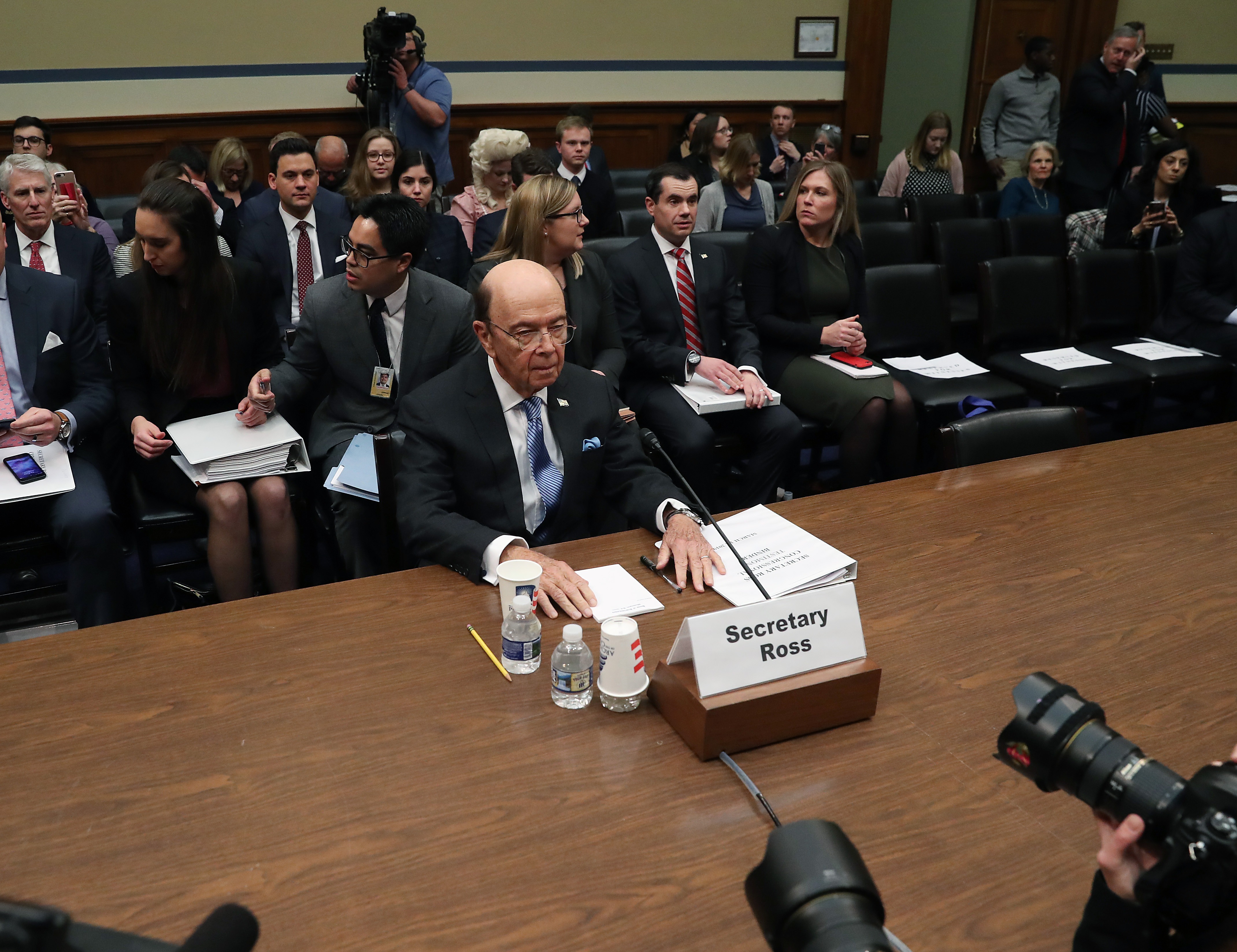Political Report
How We Count People Skews Political Power
The new citizenship question and the longstanding practice of prison gerrymandering weaponize the census to change the racial geography of power.

The new citizenship question and the longstanding practice of prison gerrymandering weaponize the census to change the racial geography of power.
In late April, the Supreme Court heard arguments in one of the most consequential cases of the term. Department of Commerce v. New York deals with the Trump administration’s decision to add a question asking about citizenship to the 2020 census. In the current political climate, when the federal government has prioritized deportations, adding such a question is expected to lead many noncitizens and their family members to not respond to the census. One study released by researchers at Harvard University projects an undercount of 4.2 million Latinx residents; other research projects significant undercounts as well. This will undermine the basic function of the census: an accurate count. That enumeration is, as Adam Liptak put it on a recent episode of the podcast The Daily, “the very cornerstone and foundation of our political system.”
The undercount would be significant enough that states with larger immigrant populations could end up with fewer seats in the House of Representatives than they should have. This dynamic will also play out within each state when the time comes to redraw political districts. An undercount will increase the number of districts in areas that do not have a major immigrant population, while also funneling more state and federal funding toward those districts.
The stakes are high: If this change to the decennial census is allowed it will translate into the dilution of political representation for diverse, immigrant-rich population centers and their inhabitants. And making a citizen count available could enable conservative states to distribute political representation based not on the number of people, but on the number of citizens. This, too, would lead to a shift in political power within states, away from more diverse areas.
The Supreme Court will decide whether to allow the change. In the meantime, though, the census already counts people in a way that dilutes the power of communities of color, and of urban areas, while inflating that of white and rural communities.
Despite longtime pleas from advocates, the Census Bureau will, for the 2020 census, continue to count people in prisons where they are incarcerated, and not at the home addresses where they lived before incarceration and where they will most likely return upon release. (The census adopted changes to treat some deployed military personnel and children in juvenile treatment facilities differently, and count them at their last home addresses.) Most states use this data to draw their districts, a practice known as prison gerrymandering. The result, given the concentration of prisons in rural districts, and the disproportionate imprisonment of people from urban areas and from communities of color, is “a systematic transfer of population and political clout from urban to rural areas,” writes the Prison Policy Initiative, as well as toward predominantly white ones.
Prison gerrymandering is just one of a set of practices that leaves the communities most targeted by the policies of mass incarceration with the least power to effect change at the ballot box. Large swaths of people are arrested and forcibly moved from predominantly nonwhite areas to predominantly white ones whose population totals, political representation, and funding they inflate. Simultaneously, since people incarcerated over felony convictions are barred from voting in all but Maine and Vermont, these people are denied any voice in the communities gaining power from their presence. They are “ghost constituents.” This policy “deflates the weight of votes in areas targeted for criminal justice enforcement … exacerbating the cycle of democratic exclusion,” wrote Julie Ebenstein, an attorney with the ACLU’s Voting Rights Project, in a 2018 law review article.
A new study of Pennsylvania shows the extent to which prison gerrymandering dilutes the political power of non-white residents and urban communities. Brianna Remster and Rory Kramer of Villanova University looked at every Pennsylvania district and examined the effect of counting people in their home districts rather than where they were incarcerated. What they found was that for at least eight districts, the population shift would be large enough that the districts would violate the principle that districts must have equal populations within a reasonable deviation. Four would have too many people and four too few. Three of the four districts that would have far too many constituents are in Philadelphia where “over 100,000 Black residents…do not experience representational equality as defined by the Supreme Court.”
“The incarcerated are not only missing from their communities, they are also benefiting other communities,” write Remster and Kramer. Specifically, they conclude that when it comes to political representation, “Black and Latino voters are being diluted in comparison to White voters because Blacks and Latinos are less likely to live in districts in which prisoners inflate the number of non-voting residents compared to Whites.”
Representation is similarly skewed in other states. The NAACP noted in a lawsuit that “for every 85 residents in District 59,” a largely white area of Connecticut that includes three prisons, “there are over 100 residents in District 97,” which is in New Haven, a majority-nonwhite city. In New York, as documented in a Demos report, there were seven Senate districts after the 2000 redistricting that met the minimum population requirement only if you counted the people incarcerated there; all seven were rural districts represented by Republicans. In Texas, there are several rural counties where approximately one-fifth of the population is incarcerated, lending power to these areas at the expense of urban centers like Houston; the New York Times reported in 2011 that Harris County would be entitled to an additional legislative district if Houstonians incarcerated around the state were to be counted there.
“We’re talking resources away from economically disempowered communities where people used to live,” state Senator Will Haskell, a Connecticut Democrat who this year introduced legislation to allow incarcerated people to vote, said in a phone interview.
Although the most comprehensive solution to prison gerrymandering must come from the federal Census Bureau, states have begun to take action.
In Washington State, lawmakers adopted legislation last month to end prison gerrymandering. If Governor Jay Inslee signs it into law, it will require the state to count incarcerated people at their last known address, rather than where their prison is located, for purposes of redistricting.
Washington would be the fifth state to adopt such a reform. Maryland and New York already modified how they count incarcerated people at the beginning of this decade, and California and Delaware are poised to follow during the round of redistricting that will follow the 2020 census. In addition, in Maine and Vermont, people who are incarcerated can vote at the last address at which they were registered prior to incarceration.
Although the Census Bureau does not collect prisoners’ home addresses, states identify the number of people whom the census has counted as residing at the prison. Then they obtain from agencies like the Department of Corrections information about the last known addresses of people who were incarcerated at the time of the bureau’s count, and they relocate these people to that last address before conducting redistricting. These states differ on how to deal with the fact that the information provided by the Census Bureau is currently incomplete on this matter; they also differ on whether they use this method for both legislative and congressional redistricting.
Other states are debating ending prison gerrymandering, including Connecticut, New Jersey, and Oregon. In New Jersey, Republican Governor Chris Christie vetoed such legislation in 2017 but Democrats are pushing it again now that he is out of office.
One obstacle to ending prison gerrymandering is that lawmakers whose districts contain prisons often defend the increased representation and funding it gives to the areas they represent. Connecticut Representative Liz Linehan, a Democrat whose Cheshire-based district includes a state prison, said this year that she opposed reform because it “would have a significant negative impact on Cheshire’s state aid and operating budget.” Cheshire is a predominantly white town; 70 percent of the people incarcerated in Connecticut are Black or Latinx, according to the Prison Policy Initiative, and many resided in the diverse cities of Bridgeport, Hartford, and New Haven. Similarly, New York Republicans whose districts benefited from prison gerrymandering sued against the state law to reform that practice in 2011. (Courts upheld the law.)
The questions about who is counted, and where, are deeply political. How we count people has been weaponized to change the racial geography of political power in at least two ways. The citizenship question will undercount people who live among their family and communities, while prison gerrymandering fully counts disenfranchised individuals in the places to which they have been forcibly transferred, denying both them and their pre-incarceration neighborhoods meaningful political representation.
This article is a joint production of the Daily Appeal and the Appeal: Political Report.
